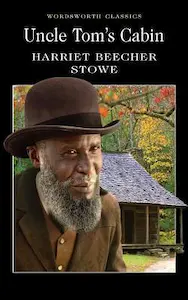Uncle Tom's Cabin - Summary
Harriet Beecher Stowe

Introduction
“Uncle Tom’s Cabin” by Harriet Beecher Stowe is a groundbreaking novel that was published in 1852. This powerful book played a significant role in shaping public opinion about slavery in the United States during the mid-19th century. Through vivid storytelling and compelling characters, Stowe exposes the harsh realities of slavery and advocates for its abolition. In this book summary, we will delve into the key themes, characters, and events that make “Uncle Tom’s Cabin” a timeless masterpiece.
The Cruelty of Slavery
One of the central themes of “Uncle Tom’s Cabin” is the cruelty and inhumanity of slavery. Stowe vividly portrays the physical and emotional abuse suffered by enslaved individuals through her characters. Uncle Tom, the protagonist of the story, is a kind-hearted and devoutly religious slave who endures various hardships. His unwavering faith and resilience in the face of adversity serve as a powerful symbol of the strength of the human spirit.
The Impact of Family Separation
Stowe also explores the devastating impact of family separation caused by slavery. Eliza, another key character, is a young slave mother who escapes with her son Harry to avoid being sold. The heart-wrenching scene of Eliza crossing the icy Ohio River to protect her child became one of the most iconic moments in the novel. Through Eliza’s story, Stowe highlights the dehumanizing effects of tearing families apart and emphasizes the importance of love and unity.
The Hypocrisy of Christian Slaveholders
In “Uncle Tom’s Cabin,” Stowe criticizes the hypocrisy of Christian slaveholders who claim to be devout followers of the Bible while owning slaves. She exposes the contradiction between their professed religious beliefs and their participation in the institution of slavery. Stowe challenges the notion that Christianity and slavery can coexist, arguing that true Christian values should promote love, compassion, and equality.
The Complexity of Slave Characters
Stowe’s portrayal of slave characters in “Uncle Tom’s Cabin” goes beyond simple stereotypes. She presents a diverse range of enslaved individuals, each with their own unique personalities, hopes, and dreams. From the innocent and tragic Eva to the rebellious and fiercely independent Cassy, Stowe humanizes these characters and challenges the prevailing racist stereotypes of the time.
The Role of Women in the Abolitionist Movement
Another significant aspect of “Uncle Tom’s Cabin” is the portrayal of strong women who play vital roles in the abolitionist movement. Characters like Eliza, Eva, and Cassy are depicted as courageous and determined, actively working towards the eradication of slavery. Stowe’s inclusion of these powerful female characters was groundbreaking at the time, as it challenged traditional gender roles and highlighted the important contributions of women in social change.
The Power of Literature in Shaping Public Opinion
“Uncle Tom’s Cabin” had a profound impact on public opinion and was instrumental in fueling the abolitionist movement. Stowe’s novel reached a wide audience and sparked intense debates about the morality of slavery. By using storytelling as a tool for social change, Stowe effectively conveyed the horrors of slavery and helped sway public sentiment against this oppressive institution.
Controversy and Criticism
While “Uncle Tom’s Cabin” received widespread acclaim, it also faced significant controversy and criticism. Some accused Stowe of exaggerating the realities of slavery or portraying slaveholders too harshly. However, the novel’s enduring legacy and its ability to provoke discussions about race, equality, and justice cannot be denied.
The International Impact
Beyond the United States, “Uncle Tom’s Cabin” had a profound international impact. Translated into numerous languages, the novel reached readers across the globe and contributed to the growing anti-slavery sentiment. It exposed the harsh realities of American slavery to an international audience and helped shape public opinion on a global scale.
Legacy and Historical Significance
“Uncle Tom’s Cabin” remains a significant work of literature that continues to be studied and celebrated today. It played a pivotal role in the fight against slavery and is often credited with helping to lay the groundwork for the American Civil War. Stowe’s novel challenged the status quo, humanized enslaved individuals, and inspired countless readers to join the abolitionist cause.
Conclusion
In conclusion, “Uncle Tom’s Cabin” by Harriet Beecher Stowe is a powerful and influential novel that exposed the cruelty of slavery and advocated for its abolition. Through vivid storytelling and memorable characters, Stowe brought the horrors of slavery to the forefront of public consciousness. The book’s exploration of themes such as family separation, religious hypocrisy, and the role of women in social change resonated with readers and helped shape public opinion. Despite facing controversy and criticism, “Uncle Tom’s Cabin” remains a timeless masterpiece that continues to inspire and educate readers about the importance of justice, equality, and compassion.